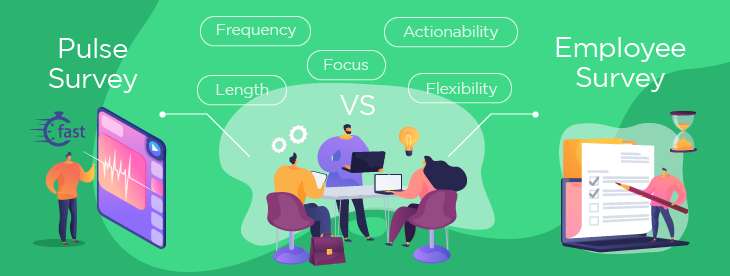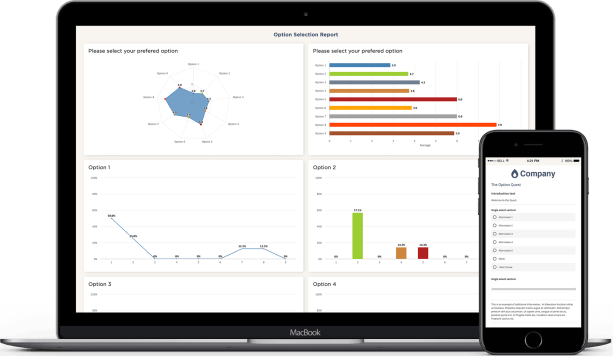Five Differences Between a Pulse Survey and an Employee Survey


Employee pulse surveys are popular tools for gaining rapid and frequent employee feedback on critical matters. Done right, we show how you can use a pulse survey as a transformational leadership tool.
This guide covers everything you need to know about employee pulse surveys, including how they differ from traditional employee surveys. You will discover a pulse survey’s stand-out characteristics and how and why they have evolved into a powerful tool since their need was recognised in the 1920s. We also highlight their distinct advantages to businesses, what they should focus on, and how to construct and deliver pulse surveys according to best practices.
Summary: What Is Best Practice in Employee Pulse Surveys?
Short, frequent employee pulse surveys involve asking questions on your organisation’s most pressing, current strategic issues. To gather transformative insights, measure trends over time, ensure responses are anonymous, and you respond quickly and transparently on employee feedback to signal you value the employee voice.
Table of Contents
- What is an employee pulse survey?
- Five differences between a pulse and an employee survey
- A brief history of employee pulse surveys
- Benefits of employee pulse surveys
- What should pulse surveys focus on?
- Essential Pulse Survey Questions
- Best Practices in Using Pulse Surveys
- A Final Note
Try Questback 14 days for free.
What is an Employee Pulse Survey?
An employee pulse survey is a short, frequent survey designed to gather timely feedback and valuable insights from employees. Due to their flexibility, they can tap into any pressing work-related topic, from organisational culture to job satisfaction and intervention effectiveness.
Frequent polling of employees provides your organisation with a quick and easy way to monitor employees and their relationship with the workplace and identify any potential issues or areas of improvement. As such, pulse surveys serve as regular check-ins to actively listen to and respond to the employee voice.
But what are the differences between a pulse survey and an employee survey?

Five Differences Between a Pulse and Employee Survey
While both employee pulse surveys and employee engagement surveys aim to measure employee satisfaction and engagement, there are five key distinctions.
- Frequency: Employee pulse surveys are conducted more frequently than employee engagement surveys. Whereas an employee survey is typically conducted annually or bi-annually, pulse surveys are often deployed monthly, quarterly, or even weekly.
- Length: Employee pulse surveys are much shorter than employee engagement surveys. They need only a few questions and can be completed in just a few minutes. In comparison, employee engagement surveys may contain dozens of questions and take much longer to complete.
- Focus: Employee pulse surveys focus on gathering feedback on specific issues or topics, such as communication, work-life balance, or manager support, while employee engagement surveys are designed to measure overall engagement and satisfaction with the organisation.
- Flexibility: Unlike traditional employee surveys, pulse surveys are not bound by strict rules — you choose what a pulse survey should focus on. This lets your business focus on what matters most to your company now.
- Actionability: Employee pulse surveys provide more immediate and actionable insights that can be used to make quick changes and improvements. In contrast, engagement surveys provide a more comprehensive picture of employee engagement that can inform longer-term strategies and initiatives.
Both survey types provide immense value. Therefore, it’s wise not to take an either/or stance. Both survey types work best in concert to derive the best return on investment for your business.

Use Employee Pulse Surveys to figure out what drivers that works at your workplace!
In this whitepaper, you will find 33 concrete tips that you can act on to immediately increase employee engagement at your workplace.
The History of Employee Pulse Surveys
Most claim that pulse surveys date back to the early 2000s when organisations began to recognise the need for more frequent and timely employee feedback. Yet while the term ‘pulse’ is relatively new, their rationale and origins date back to the 1920s.
Typically called employee attitude testing and pioneered by researcher David Houser, the link between employee morale and efficiency started to gain the attention of top executives and academics during the 1920s and 1930s.
Yet despite pioneering research among behavioural scientists, surveying employee attitudes were limited to a handful of progressive companies. It wasn’t until after World War II that momentum grew, and its popularity soared. Yet its boom also came with suspicions of bias — would workers speak truthfully about their actual experiences? This gave rise to locked “ballot boxes” and other measures to rapidly gain feedback and ensure anonymity, a point we cover shortly.
Since these early developments, and their fluctuating popularity, pulse surveys have increased in sophistication — better measures and improved guards against bias. And today, they are now more widespread and popular than ever due to technological advances, such as online survey platforms and mobile apps. Indeed, providers such as Questback now make it far easier and more efficient to administer pulse surveys and collect real-time employee feedback.
So why are pulse surveys so popular today? As shown next, they offer several distinct advantages for any organisation.
Benefits of Employee Pulse Surveys
Today, pulse surveys are used by organisations of all sizes and across various industries. Why? Due to numerous high-impact business benefits. Here are some notable advantages:
We live in a VUCA world. No business can escape the realisation that the world is increasingly volatile, uncertain, complex, and ambiguous. Unsurprisingly, an annual survey misses the ‘real time’ thoughts, attitudes, and concerns of staff. Instead, it’s essential to tap into what your employees are thinking and feeling right now. And as highlighted earlier, due to a pulse survey’s flexibility, its probing questions can adapt to whatever matters most at the current time.
Data-driven decision making. The inconvenient truth of long surveys is their lower response rates. The longer and more complex a survey instrument, the lower the response rate — this threatens representativeness and undermines its potential value. Therefore, pulse surveys typically deliver robust data. That is, pulse data are more indicative of what most employees want, not just a vocal minority. What’s more, this data-driven approach drives agile improvements. Therefore, pulse survey insights allow your business to make more informed decisions aligned with representative employee needs, priorities, and preferences.
Generate significant cost savings. When employers receive and act on timely feedback, this generates significant cost savings. When organisations let problems grow unattended, this undermines productivity, brand equity, and employee turnover rates. In contrast, if acted upon, pulse survey insights nip problems in the bud before issues escalate and incur higher costs.
Improved organisational culture. Pulse surveys help organisations create a positive and supportive culture via several mechanisms. First, regular polling communicates that the employee voice is valued — this builds trust, commitment, and employee engagement. Moreover, if the employer is responsive, they identify opportunities to make changes that benefit employees. This results in a more positive work environment and higher brand equity, which helps attract and retain top talent.
Measure trends over time: Whichever topic you focus your pulse survey on, your ability to plot and track trends over time is a distinct advantage. For instance, is morale, engagement, trust, etc, getting better or worse over time? Are your interventions making a difference? Visualising this data on dashboards gives you quick and effective access to how employees are faring due to the consistency and regularity of asking your employees what they think and feel.
All told, pulse surveys provide an agile tool to measure and transform employee engagement, productivity, retention, and accountability.
What should pulse surveys focus on?
With so much freedom of choice, what should your pulse surveys focus on? The ultimate decision should reflect your current objectives, specific issues or concerns. As food for thought, here are some common themes pulse surveys often focus on:
Employee engagement: Questions about employee engagement, enthusiasm, and commitment to work and your organisation.
Managerial support: Questions about the quality of the support and guidance employees receive from their managers, including feedback, recognition, and coaching.
Communication: Questions about communication effectiveness within your organisation, including clarity of messaging and frequency of updates.
Workload and work-life balance: Questions about employees’ workload, workload distribution, and ability to maintain a healthy work-life balance.
Career development: Questions about employees’ perception of opportunities for career growth, advancement, and skill development within your organisation.
Diversity, equity, and inclusion: Questions about employees’ experience of diversity and inclusion within your business, including perceptions of fairness and opportunities for all employees.
Health and well-being: Questions about employees’ physical and mental health, including access to resources and support.
Irrespective of your focus, what type of pulse questions should you ask?
Try Questback 14 days for free.
Essential Pulse Survey Questions
Once you’re clear on your strategic focus, you need to operationalise your focus into question items.
To do this well, you need to think about the what and why. Firstly, what is the key outcome you are most interested in? You will also need to construct questions to probe why — the driver(s). Miss these, and you’ll struggle to discover the optimal solution.
Given the need for brevity, there is little room for manoeuvre — all questions should be must-haves to benefit from the pulse approach. At Questback, we have a bank of robust questions and recommend no more than 15 or 20 at most. However, it could be as few as five or even fewer.
Now that you know what to focus on and how many questions you need, it’s pertinent to consider which question types you will use. We recommend using closed questions in large part and some open-ended questions.
A top-priority closed-ended question should measure the strategic outcome you are interested in. For instance, the Employee Net Promoter Score is a popular choice, as in, “How likely are you to recommend your employer to a colleague or friend?”.
A collection of closed-ended questions is also required to measure what influences your strategic outcome. These questions could be Likert scales (e.g., strongly disagree to strongly agree), semantic scales (e.g., unnecessary to necessary), and ranking questions to probe perceived priorities.
As helpful as closed questions are, you risk missing what’s driving the strategic outcome you measure, e.g., employee engagement. That’s why including one or two open-ended questions is especially important. An open input question allows employees to “get things off their chest”. By offering opportunities for cathartic responses, you increase the likelihood of revealing overlooked issues.
Yet while well-constructed questions are considered best practice, the full potential of your pulse surveys will not be fully realised unless you consider a range of other important practices.

Best Practices in Using Pulse Surveys
Done well, pulse surveys are highly valued leadership tools to leverage transformative change. Here we outline 6 practices to maximise the benefits.
- Find your frequency “sweet spot”. Overdoing it will create survey fatigue; underdoing it, you’ll miss opportunities and risk negative impacts. To discover the optimal rate, it’s best to track response rates and gather employee feedback. Once you’ve found your optimal frequency, consider the optimal number of questions. For instance, if bi-weekly, it’s best not to ask too many questions, e.g., no more than 5 to 10. In contrast, if a quarterly rate is optimal, it affords to ask several more questions.
- Automate your pulsing. Deploying a range of different survey types is hugely cumbersome if you don’t automate your approach. With a customer and employer insights solution like Questback, clients benefit from the smooth and efficient operation of surveys, in-house expertise, and data visualisation tools to extract maximum insights. In brief, automation takes the hassle out of implementation and increases the generation of actionable insights to transform your business.
- Protect anonymity and confidentiality: Employees should feel comfortable and safe sharing their feedback, so it’s essential to protect their anonymity and confidentiality. This means ensuring that responses are 100% anonymous and cannot be linked to individual employees. For best practices regarding survey anonymity, see our blog post on [insert link/keywords].
- Act on insights. Pulse data holds no value unless you act on insights. That means you need to act on a timely basis. If you omit or avoid action for too long, employee trust will likely break down, and scepticism will increase. As such, allocate time upfront to follow up swiftly on generated insights.
- Follow up transparently: Taking action loses its impact if communication is lacking. By taking a “you said, we did” approach, you send a strong signal to all employees — your voice makes a difference. Following up needs to communicate any changes or improvements resulting from pulse surveys. Moreover, it’s essential to keep employees informed of ongoing progress. This builds and maintains employee trust and engagement in the survey process.
- Have a system in place. Systems, frameworks, and models bring structure to complex processes. The Data-Dialogue-Action-Results model devised by Professor Theresa Welbourne is a helpful framework to guide pulse survey processes. It involves: (1) Data – acquiring and analysing pulse data, (2) Dialogue – understanding and exploring the story your employees are telling you, (3) Action – making sure you make insights actionable and enabling of change, and (4) Results – sharing results to demonstrate the power of the employee voice.
A Final Note
Pulse surveys are not a nice-to-have. This tool, if used well, generates transformative change. Their success, however, relies on valuing and trusting the employee voice. Therefore, the best way to generate business results is to act on anonymous, consistent, robust, and regular pulsed measures of your employee voice.
FAQ
Short, frequent employee pulse surveys involve asking questions on your organisation’s most pressing, current strategic issues. To gather transformative insights, measure trends over time, ensure responses are anonymous, and you respond quickly and transparently on employee feedback to signal you value the employee voice.

Try Questback
Questback is a leading Customer and Employee Experience solution that makes it easy to collect, analyse and take action on key stakeholder insights.









